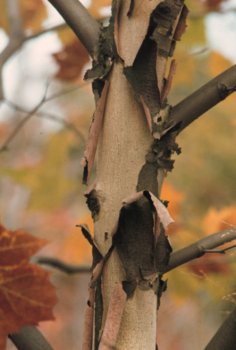In the lush green of summer, the bark of woody plants is barely noticeable. Winter strips all that away, though, and invites us to pay more attention. A close look at the bark of many trees reveals far more intricacy and complexity than simple protection would require.
Although it takes many years for bark to reach its mature stage, some trees are worth planting for this characteristic alone. In some cases, the texture is so unique they can be identified simply by touch.
The following trees have very dramatic, noticeable bark:
American Sycamore (Platanus occidentalis): Well known for its patchwork bark of white, cream, olive and shades of brown.
Aspen: The smooth greenish-white to cream-colored bark of quaking aspen is a real treat in the landscape. The bark is especially attractive against an evergreen backdrop or dark-colored home.
Bald Cypress: Shaggy, cinnamon-colored bark stands out against light green needles. In mature trees, it peels off in long strips and is further accented by the low, flared trunk and strong branching structure.
Birch: Several types of birch trees have exfoliating bark. The paper birch has a chalky-white bark that peels into thin paper-like layers. The river birch stands out with its exfoliating orange to cinnamon brown bark that peels freely when young. These papery sheets reveal white to salmon-colored inner bark.
Coffeetree: Few deciduous trees match the leafless beauty of coffeetree. Its coarse outline and stucco-like bark make it an eye catcher in the winter landscape.
Cornelian Cherry Dogwood: Scaly, exfoliating bark is a mix of gray and tan.
Crape Myrtles: The smooth, shiny bark of these trees creates a great winter texture and interest. Many newer varieties have bark that is mottled in color and exfoliating. Varieties like Natchez, Biloxi and Kiowa are known for richly colored winter wood.
Hackberry: The corky ridges and wart-like projections on the trunk and bigger branches of hackberry make it an easy tree to identify.
Lacebark Elm: This bark looks like the perfect template for a camouflage design with gray, brown and orange.
Lacebark Pine: As its name implies, the bark on this tree exfoliates (much like sycamore) in a smooth patchwork of lighter and darker shades of gray and gray-brown.
London Planetree: These trees have smooth bark that exfoliates to expose gray, brown and creamy white layers in a mottled patchwork pattern.
Persimmon: Persimmon has a thick, dark (almost black) bark deeply divided into very distinctive small blocks.
Red Oak: Bark resembles ski trails and furrows.
Shagbark Hickory: Like its name implies, the bark of this hickory exfoliates in long, shaggy strips.
Striped Maple: Green bark and greenish white stripes.
Sugar Maple: A smooth gray bark gives rise to large irregular plates that give way to deep furrows.
Sweetgum (Liquidamber styraciflua): A large tree that has textural interest in the branches. Young branches have a corky wing look to them and the prickly seed balls linger throughout the winter.
Yellowwood: The gray bark on mature trees is very smooth and gray.




